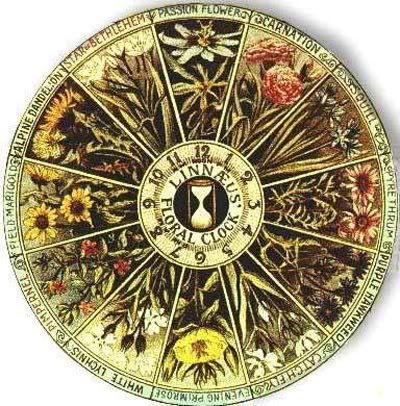
Carl Linnaeus, father of taxonomy, divided the flowering plants into three groups: the meteorici, which change their opening and closing times according to the weather conditions; the tropici, which change their opening and closing times according to the length of the day; and the aequinoctales, which have fixed opening and closing times, regardless of weather or season.
Linnaeus noted in his Philosophia Botanica that if one possessed a sufficiently large variety of aequinoctal species, it would be possible to tell time simply by observing the daily opening and closing of flowers. Though Linneaus seems never actually to have planted an horologium florae, or flower clock, his plan was taken up with great passion by many 19th-century gardeners, who often arranged a dozen or more species in the manner of a circular clock face. Below, the approximate opening and closing times of aequinoctal flowers that can be used in an horologium florae:
0200 – Night blooming cereus closes
0500 – Morning glories, wild roses
0600 – Spotted cat’s ear, catmint
0700 – African marigold, orange hawkweed, dandelions
0800 – Mouse-ear hawkweed, African daisies
0900 – Field marigold, gentians, prickly sowthistle closes
1000 – Helichrysum, Californium poppy, common nipplewort closes
1100 – Star of Bethlehem
1200 – Passion flower, goatsbeard, morning glory closes
1300 – Chiding pink closes
1400 – Scarlet pimpernel closes
1500 – Hawkbit closes
1600 – ‘Four o’clock’ plant opens, small bindweed closes, Californian poppy closes
1700 – White waterlily closes
1800 – Evening primrose, moonflower
1900
2000 – Daylilies and dandelions close
2100 – Flowering tobacco
2200 – Night blooming cereus
[Taken verbatim from the original kirchersociety.org]
No comments:
Post a Comment